Have you ever watched a pigeon or a chicken move in a strange way? They seem to strut and bob their heads in an odd pattern. This isn’t just for a few birds; many birds move like this. It looks odd to us, but it’s because of how birds evolved and their special body structure.
Picture a red-tailed hawk flying high, looking for prey below. Or a hummingbird flying fast, visiting flowers one after another. These amazing bird moves are thanks to their body, senses, and their environment.
Key Takeaways
- Birds move in a unique way, bobbing their heads as they walk or fly.
- This movement is linked to their special body and how they evolved, including their vision, neck flexibility, and lightweight skulls.
- Learning why birds move this way helps us understand how they move, see the world, and survive.
- Birds use head motion more than eye motion to see their world, which is important for their vision and how they find food.
- The way birds move their heads is not just odd; it shows how they efficiently move through their world.
Next, we’ll dive into the world of how birds move and why they seem to move oddly.
Overview of Avian Locomotion
Birds have evolved amazing ways to move, making them stand out. Their light bodies and special bones and muscles let them fly with great agility. These traits are the result of changes over time that help them survive.
Unique Characteristics of Bird Movement
Birds move in a jerky, bobbing way that looks interesting. This isn’t just for show; it’s a key adaptation. The quick head movements help keep their view steady while they move.
Evolutionary Adaptations for Flight and Survival
Birds can fly thanks to their amazing evolution. They have light bodies and muscles made just for flying. This lets them move easily through the air, helping them find food, avoid predators, and migrate long distances.
The jerky head movements also improve their vision. This is important for finding food, spotting predators, and flying well. These changes have been crucial for birds to survive and grow over millions of years.
“The glide ratio of some birds can reach up to 20, indicating they can travel up to 20 meters for every meter of altitude lost during gliding.”
The way birds move shows how form and function work together. They’ve evolved to move through their world well and succeed in many different places.
Anatomy and Physiology of Bird Vision
Explore the amazing world of bird vision and learn about the detailed anatomy of their eyes. Birds have their eyes on the sides of their heads. This helps them see more around them but makes depth perception harder. They use head movements to get more information about their world.
Placement and Structure of Avian Eyes
Birds don’t have eyes like humans do, facing forward and overlapping. Their eyes are on the sides, which helps them spot predators and see their surroundings better. Some birds even have eyes that make up to 15% of their body weight.
Their eyes are built for their needs, with special retinas and a pecten that feeds the eye. They have many photoreceptors that let them see more light than humans can.
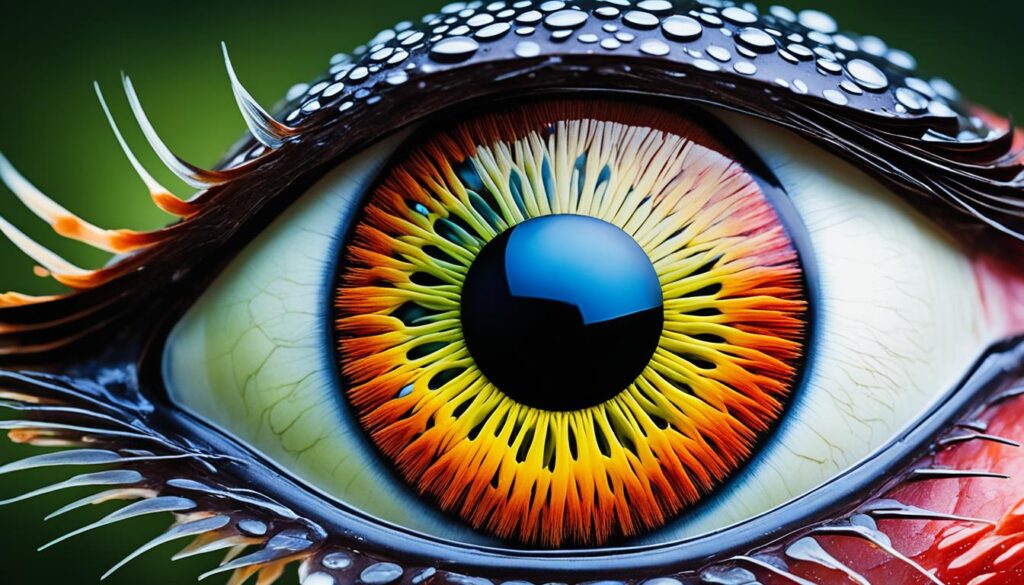
“Birds have some of the most complex visual systems in the animal kingdom, with adaptations that allow them to see things that we cannot.”
Birds have amazing visual capabilities thanks to millions of years of evolution. These abilities help them survive and behave in their environments.
The Role of Head Bobbing
Many birds, like pigeons, chickens, herons, and cranes, bob their heads in a special way. This movement helps them see depth and distance better. By moving their heads, they use a trick called motion parallax. This trick tells them how far away objects are.
Pigeons move their heads about 5 centimeters (2 inches) forward, five to eight times a second. This keeps their view clear while they move. Without this, their view would blur and they’d have trouble seeing things clearly.
This head-bobbing helps birds see what’s around them. It helps them find food and spot dangers. Even dinosaurs, the birds’ ancient relatives, might have done this too.
“Pigeons use motion parallax to see depth by watching how objects move as they move through their world.”
By moving their heads, birds use motion parallax to see depth. This is key for knowing how far away things are. They do this most during their movement cycle’s “thrust” phase.
Seeing depth and distance is vital for ground-feeding birds. It helps them find food and avoid dangers. This shows how birds have evolved to see the world better.
Why do birds move so jerky?
Birds move in a jerky way for a reason, not just for fun. Their unique eyes and evolution play a big part in this. They need to keep their vision stable and learn about their world while moving.
Birds have eyes on the sides, giving them a wide view but not much depth sense. To fix this, they bob their heads up and down. This helps them see distances and depths better.

Ground-feeding birds like pigeons and chickens do this a lot. They need to know where food and dangers are while moving. By bobbing their heads, they keep their vision steady and learn about their world.
The way a bird’s eyes and muscles work also makes them move jerky. These features help them stay stable and move through their world well.
“Birds exhibit large head movements, looking at objects with different parts of their retina and even with different eyes in rapid succession.”
Learning why birds move jerky is interesting and helps us understand their evolution. It shows how their vision and movement work together. This makes us appreciate how amazing birds are.
Maintaining Visual Stability During Movement
Birds move with agility and precision, often looking jerky to us. But this jerky look is key for keeping their vision stable. They use mechanisms for head stabilization to focus on things even when they move.
A study looked at 226 bird species and found something interesting. It showed that blinking helps keep vision stable during head turns. Blinking and head turns take about the same time, which helps keep vision steady.
Head Stabilization Mechanisms
Birds use many ways to keep their heads stable:
- Specialized Neck Muscles: Birds have muscles in their neck that work together to keep their head and eyes on one spot, even when their body moves.
- Reflexive Mechanisms: Birds have automatic ways to adjust their head and eyes to keep their view steady, no matter the movement.
- Blink Coordination: Blanking and head turns happen together, which helps keep vision stable.
These ways help birds see clearly and steadily, even when they’re moving. This is key for hunting, finding food, and avoiding predators.
“The head-bobbing behavior in whooping cranes allows their eyes to be stable and fixated on objects at least 50% of the time during foraging activities.”
Studies show that some birds bob their heads when landing, while others keep a steady gaze even when their perch moves. This shows how important it is for them to keep their eyes fixed on things.
Learning about bird visual stability helps us understand how they’ve adapted to live in different places and do various behaviors.
Ground Feeding Birds and Jerky Head Motion
Many birds, like pigeons and chickens, show jerky head movements when they forage on the ground. These ground feeding birds must always look for food on the ground. The bobbing head motion helps them keep their eyes steady while moving. This lets them find small prey or forage more effectively.
In a 1978 study with pigeons, researchers found two main head movement phases. The “thrust” phase moves the head forward by about 5 centimeters (2 inches) relative to the body. Then, there’s a “hold” phase where the head stays still. Pigeons do this jerky head movements in ground foraging birds about five to eight times a second when walking.
This head-thrusting motion helps pigeons keep their view stable as they move. It prevents their vision from blurring. Most ground feeding birds, including pigeons, chickens, herons, storks, and cranes, use this head-bobbing behavior to see their surroundings better.
Studies suggest that dinosaurs might have also had this head-bobbing behavior. But, this is still just a theory. The ability to keep their vision stable while moving is key for ground feeding birds. It helps them move through their environment and find food.
“Head-thrusting in pigeons helps them stabilize their view of the moving world around them, allowing them to process visual surroundings without blurring due to motion.”
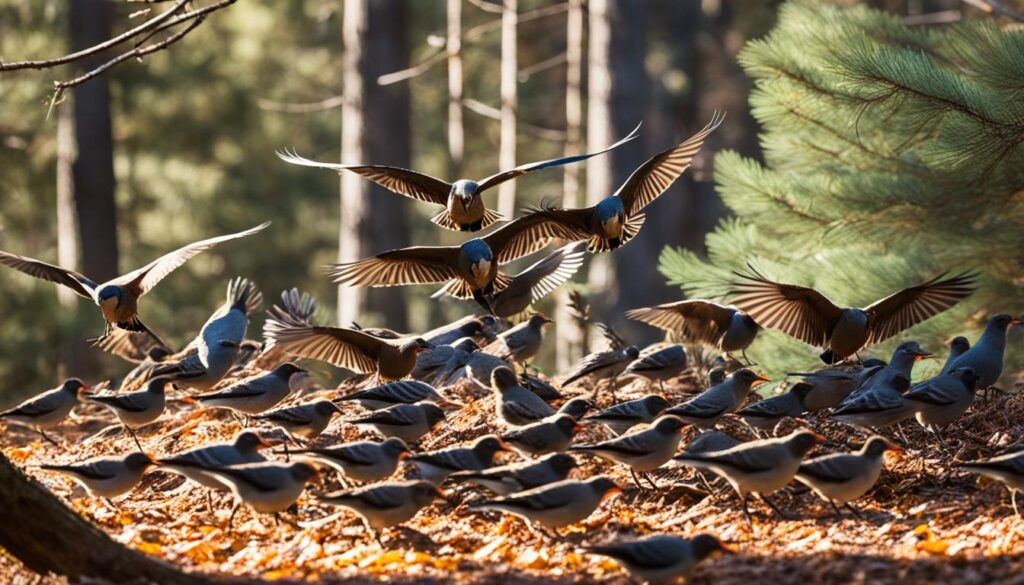
Adaptations for Predator Detection
Birds have developed amazing ways to spot predators and stay safe. They put their eyes on the sides of their head for a wide field of view. This lets them see more around them, helping them catch threats from any angle.
Wider Field of View vs. Stereoscopic Vision
But, this wide view means they don’t see depth as well, which is important for judging distances. They make up for this with jerky head movements. These movements help them see their world better and spot dangers.
Being quick to spot and react to threats is key for birds. They use their wide view and head movements to stay safe. This way, they can see clearly and avoid predators.
“Birds have disproportionately large eyes for their size, enhancing their light-gathering capabilities for activities such as foraging and predator detection.”
The trade-offs between wide field of view and stereoscopic vision in birds show how they’ve adapted to survive. These changes help them stay alert and aware of dangers in their world.
Variations Across Bird Species
Birds may look similar, but they don’t all move their heads the same way. Flightless birds like ostriches and emus move their heads more slowly than birds that fly. Wading birds, such as herons, also move their heads differently.
These differences show how different birds have adapted to their environments. Flightless birds don’t need to move their heads fast like flying birds do. Wading birds use their long legs and slow movements for hunting, which affects how they move their heads.
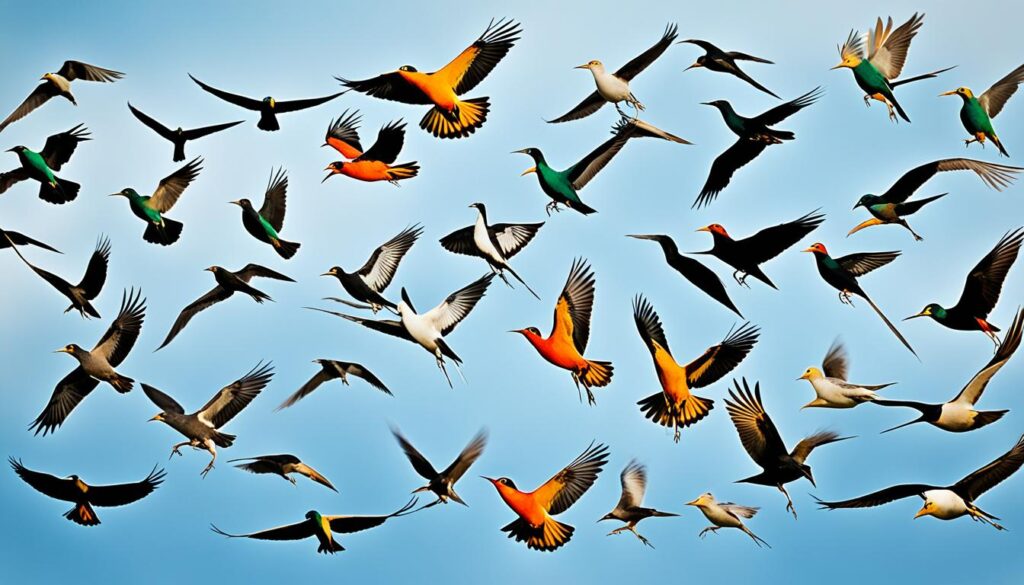
Learning about jerky head movements in flightless and wading birds helps us understand their unique ways. It shows how birds have evolved to move and see the world in different ways. This makes us appreciate the amazing variety among bird species and their evolutionary paths.
The Pecten and Eye Nourishment
A bird’s eye has a special comb-like structure called the pecten. This structure is key to feeding the retina and keeping the eyes healthy in birds.
The pecten is full of blood vessels that go into the eye’s vitreous humor. It helps supply oxygen, nutrients, and more to the retina. This is vital because birds need a lot of energy for their sharp vision.
Studies show that birds’ jerky head movements help spread these important resources around their eyes. Moving their heads helps keep the blood and nutrients flowing. This makes sure the whole retina gets what it needs to stay healthy.
This shows how the pecten and the bird’s head movements work together. It’s part of what makes birds see so well. By learning about how birds’ eyes work, we can better understand their amazing vision and behavior.
Neck Muscle Coordination
Birds’ jerky head movements are linked to how their neck muscles work with their legs. This teamwork helps them keep their heads steady while moving. It lets them see clearly and understand what’s around them.
Relationship with Leg Movements
When a bird moves its legs, its neck muscles do the opposite to keep its head still. This is key for seeing things clearly. It helps the bird keep an eye on its surroundings, even when it’s moving.
This connection between neck muscles and leg movements is a special feature of birds. It helps them move through their world, spot dangers, and find food. By keeping their heads steady, birds can track moving things, judge distances, and know where they are.
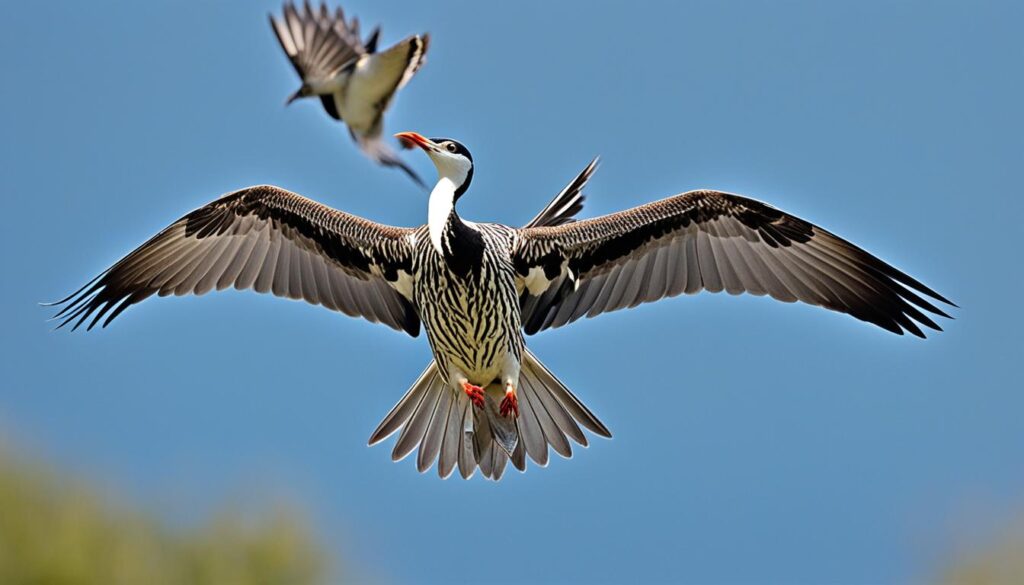
The relationship between neck muscle coordination and leg movements is a key factor in the jerky, yet stable, head movements observed in birds.
Visual Illusions and Bird Perception
Birds have a special way of seeing the world that can lead to visual illusions, just like humans do. Their unique vision and head movements help us understand why they move in jerky motions. This also shows how they navigate their environment.
Birds have an amazing visual system that lets them see things differently. Sometimes, this can make them see illusions, similar to what humans experience. By looking into how birds see the world, we learn more about their jerky movements and how they move around.
Nature has created many different ways to see the world, each with its own special features. While humans can only see a few colors, some animals like mantis shrimps can see up to 12 different colors.
“Over 40 different types of eyes exist in the natural world, each with its own specialized functions and adaptations.”
Studying visual illusions in birds helps us understand how their vision affects their movements. By seeing how birds see and make sense of their world, we can grasp why they move in jerky ways. We also learn how they move through their environment.
- Frog vision is a great example of nature’s variety in seeing the world.
- Animals use their vision to find food, shelter, and mates, and to avoid dangers.
- Machine vision is made for specific tasks, unlike the wide range of animal vision.
Looking into how birds perceive their world and their movements gives us new insights. This helps us appreciate the amazing adaptations birds have developed.
Murmuration and Flocking Behavior
Bird flocks, known as murmurations, show us how birds move together. Each bird watches its neighbors closely. This helps the whole group move as one and quickly adapt to changes.
Collective Motion and Neighbor Awareness
Scientists found that each bird in a murmuration looks at its seven closest friends. These short interactions lead to the flock moving together smoothly. This shows how birds work together and know what others are doing.
Starlings often start murmurations when they see hawks or peregrine falcons. They work together to confuse and avoid these predators. This shows how well they can move and react to dangers.
“The behavior of starling murmurations is often triggered by the presence of predators like hawks or peregrine falcons.”
Not just starlings, but other birds like Phalaropes also flock together. They show how well they can move and respond to their world.
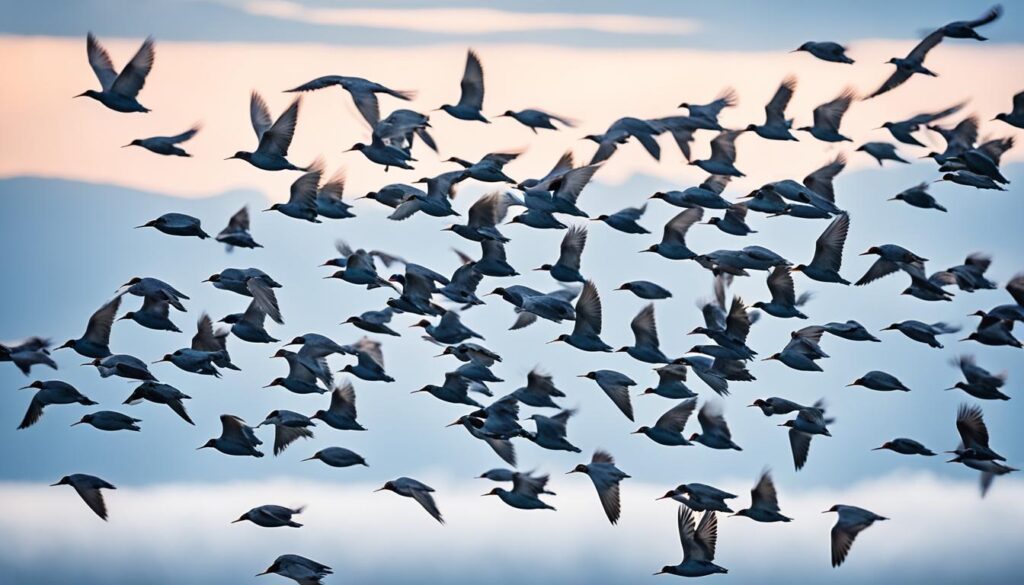
Studying bird murmurations and flocking behavior is still exciting for scientists and bird lovers. They are learning more about how these amazing events happen.
Evolutionary Trade-offs and Adaptations
The jerky movements of birds come from a complex mix of evolutionary trade-offs and adaptations. Birds balance the need for a wide view, spotting predators, and moving well with their vision and skeleton limits. This balance shows how birds have evolved to be amazing.
Birds trade off a wide view for depth perception. A wide view helps them see their surroundings better but reduces their depth sense. This is key for hunting, avoiding obstacles, and moving through their world.
Another trade-off is between stable vision and quick head movements. Birds keep their vision steady in flight and fast movements with special head and neck systems. But, these systems also cause the jerky head movements seen in birds eating on the ground.
“The distinctive jerky movements of birds are the result of a complex set of evolutionary trade-offs and adaptations.”
These trade-offs have shaped the many adaptations in birds. Flightless birds like ostriches and penguins have different ways of seeing and moving than flying birds. Wading birds have special head and neck coordination for hunting in water.
Understanding how birds balance their adaptations helps us see their amazing evolution. This knowledge not only amazes us but also deepens our view of the natural world and how species evolve.
Research and Future Studies
Research and new tech are helping us understand why birds move in jerky ways. Tools like advanced imaging, behavioral studies, and modeling are key. They help us see how birds’ bodies, eyes, and movement work together.
As tech gets better, we’ll learn more about how birds behave and adapt. This will greatly expand our knowledge of the bird world.
Emerging Technologies in Avian Research
Scientists are using new tech to study how birds move and act. High-speed cameras and motion capture systems let them see bird movements very clearly. Computational models and machine learning algorithms help them understand bird flight and how birds keep their heads still.
Miniaturized tracking devices and GPS systems track birds in the wild. They show us why birds move their heads in jerky ways. These new tools are changing how we study birds, making our understanding of them much deeper.
“The future of avian research is incredibly exciting, as we continue to uncover the intricacies of bird behavior and adaptations using cutting-edge technologies.”
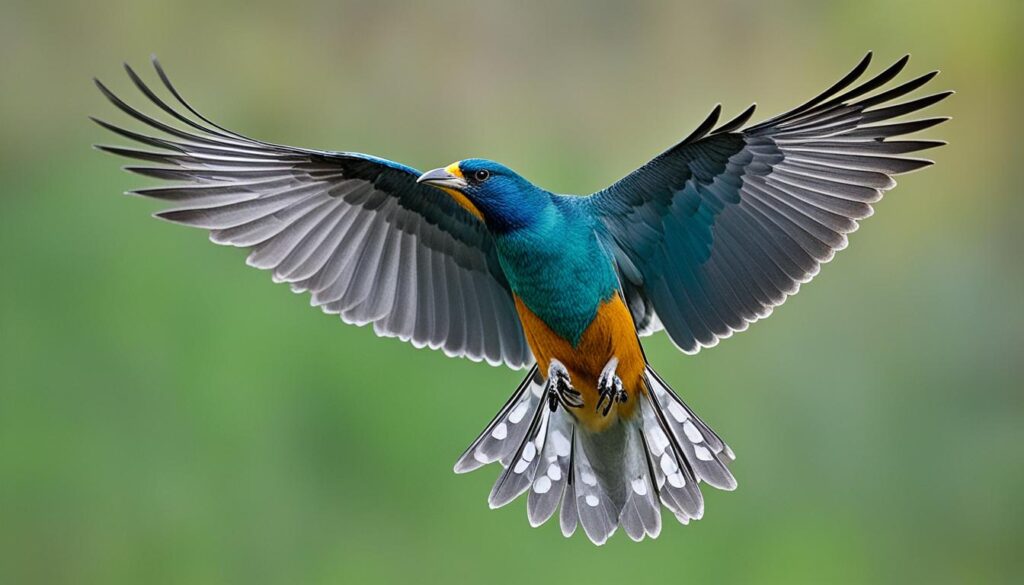
Conclusion
Birds move in a jerky way due to their unique traits and how their eyes, neck muscles, and movement work together. This helps us understand how birds move through their world, spot dangers, and live in different places.
Studies show how birds use their eyes and neck to stay stable while moving. They also have to choose between seeing a wide area or seeing things clearly up close. New research and technology will help us learn more about how birds adapt.
Looking into why birds move jerkily reveals how their body, senses, and survival skills work together. This knowledge not only makes us more curious about nature but also helps us protect these amazing birds and interact with them better.
FAQ
What is the reason for the jerky movement of birds?
Birds move their heads in a jerky way for a few reasons. These movements help them see clearly while moving. They also help them learn about their world.
How does the structure and placement of a bird’s eyes affect their head movements?
Birds have eyes on the sides of their heads. This gives them a wide view but less depth vision. Their head movements help them see distances better, making up for their vision limits.
What role do the neck muscles play in the jerky movements of birds?
The neck muscles of birds work with their leg movements. This helps keep the head stable while moving. It lets birds see and navigate their world better.
How do ground-feeding birds like pigeons and chickens use their jerky head movements?
Ground birds use their head bobbing to scan for food. It keeps their view steady while they move. This helps them find small food and forage well.
Do all bird species exhibit the same degree of jerky head movements?
No, not all birds move their heads the same way. Flightless birds and waders move their heads less than ground birds or flying birds.
How do the unique visual adaptations of birds contribute to their jerky movements?
Birds’ wide-eyed view helps them spot predators better. But, it means they see depth less well. Their head movements help them make up for this, letting them see and detect things better.
What is the role of the pecten in the jerky movements of birds?
The pecten is a special structure in a bird’s eye. It helps feed the retina and keep the eye healthy. Some think these head movements help spread nutrients and oxygen in the eye, adding to the jerky motion.
How do bird flocks exhibit coordinated jerky movements?
Bird flocks move together in a jerky way, called murmuration. Each bird watches its neighbors closely. This lets the whole flock move together and react fast to changes.
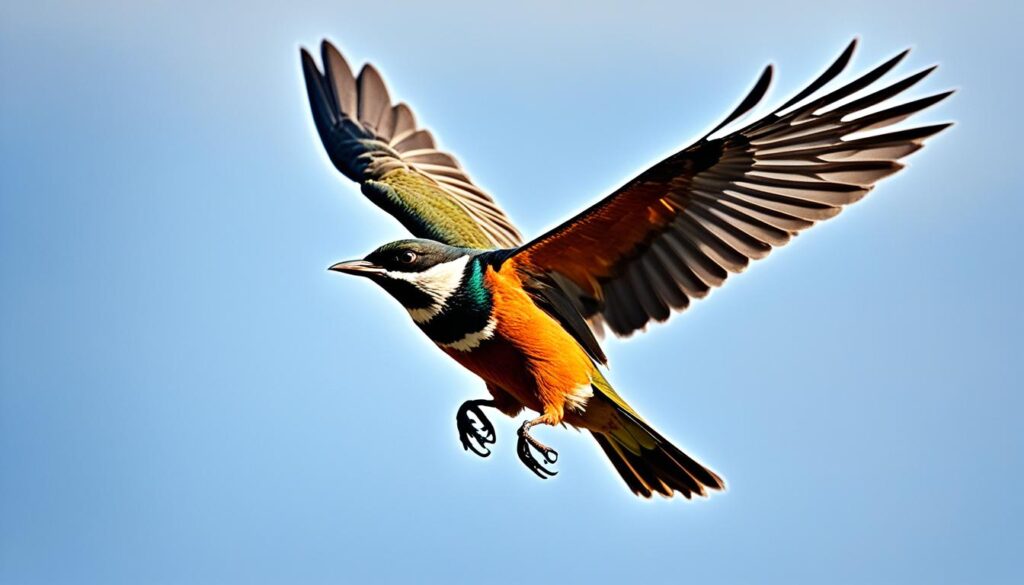

I am really inspired together with your writing skills and also with the structure for your
blog. Is that this a paid theme or did you customize it
your self? Anyway stay up the excellent quality writing, it is rare to peer a great weblog
like this one these days. Blaze AI!
My spouse and I absolutely love your blog and find nearly all of
your post’s to be exactly I’m looking for. can you offer guest writers to
write content available for you? I wouldn’t mind creating a post or elaborating on a lot of the subjects you write about here.
Again, awesome website!
my site: nordvpn coupons inspiresensation
nordvpn 350fairfax
This is a topic which is near to my heart… Take care!
Exactly where are your contact details though?
Check out my blog nord vpn promo